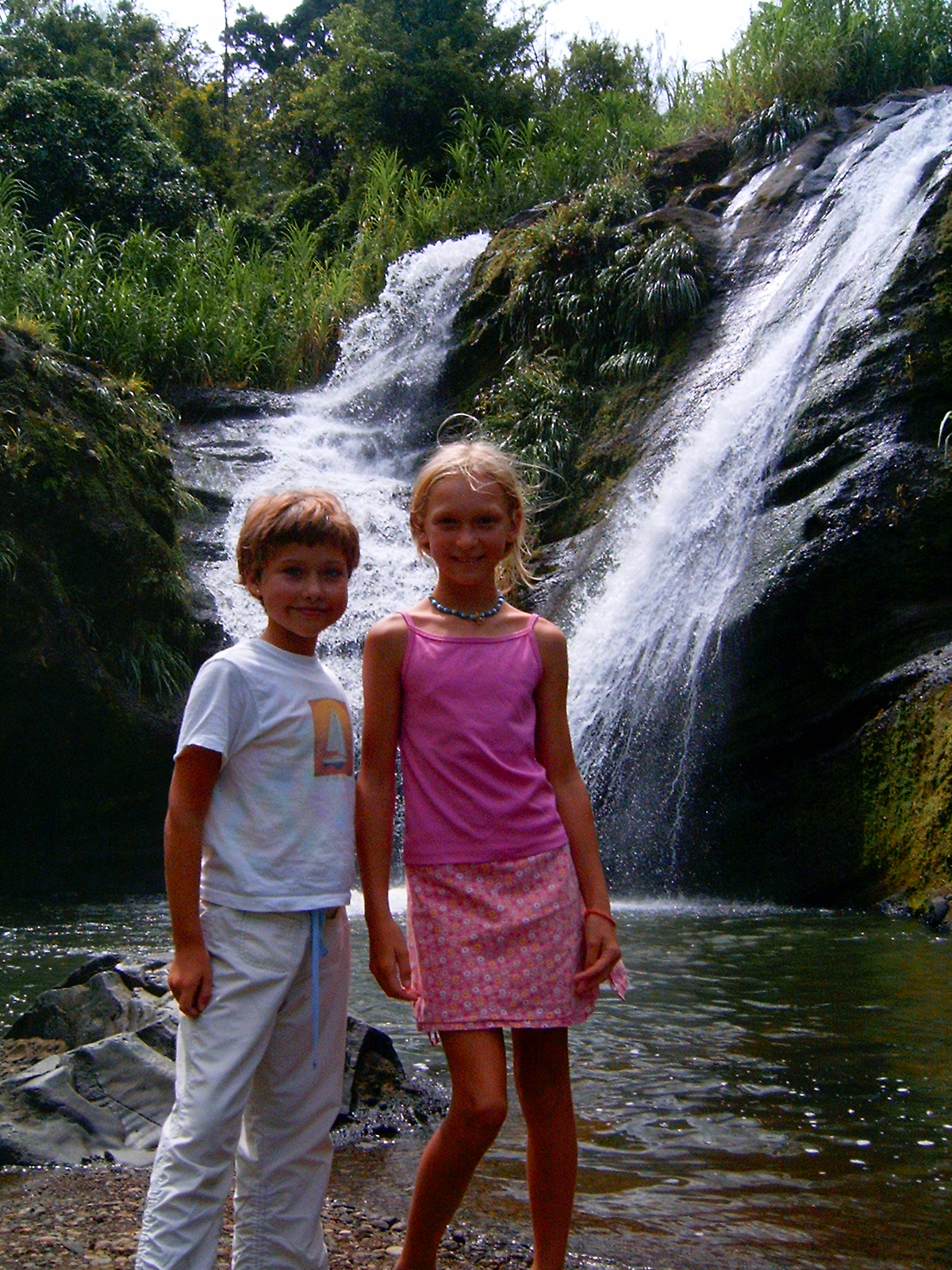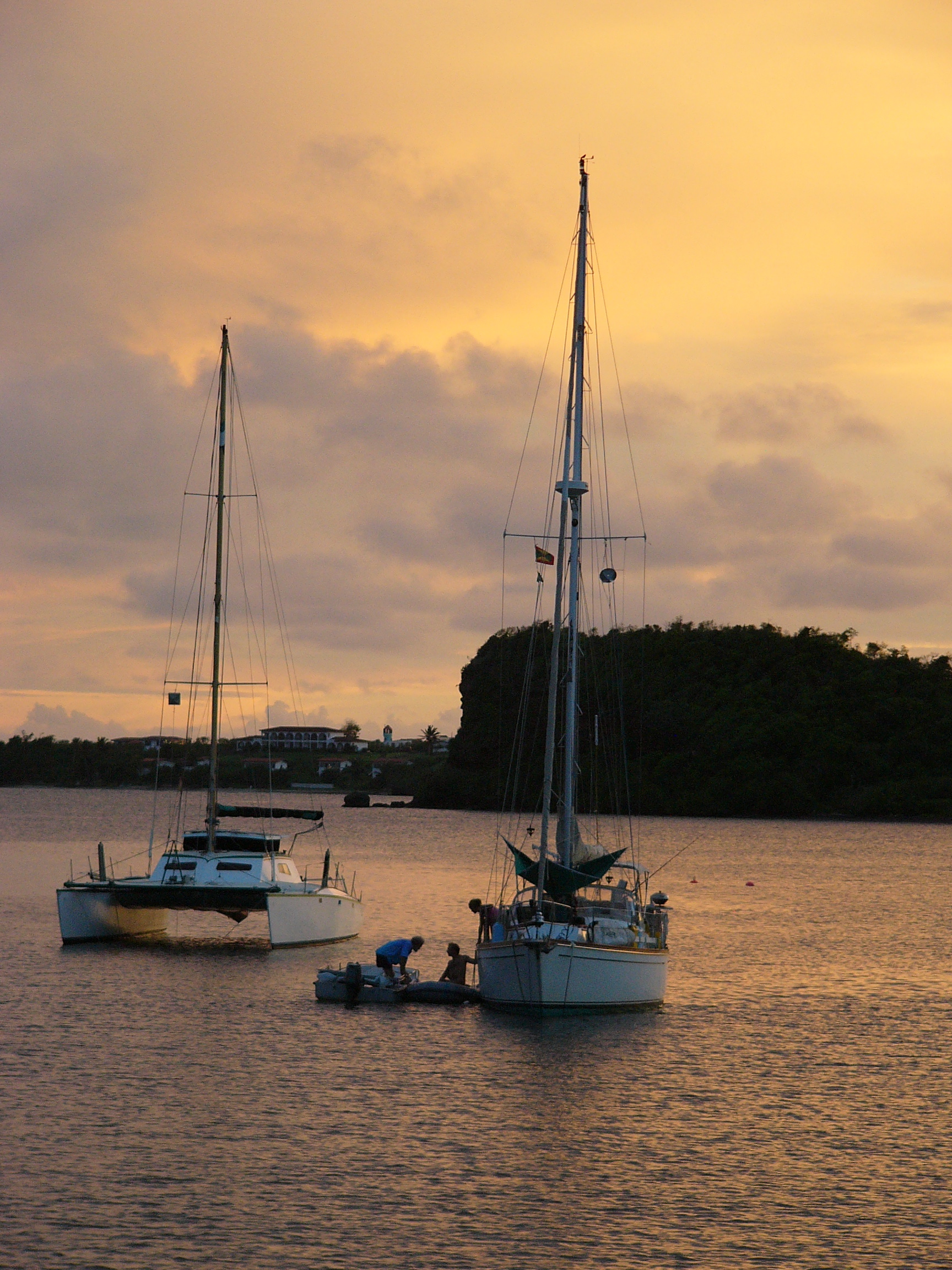June 17, 2005 - Grenada
Hog Island anchorage, Grenada
We are really enjoying Grenada! We arrived six days ago, after an easy morning's sail down from Carriacou (we caught a Little Tunny en route, it was so nice to have fish for dinner again!) Grenada is a beautiful island, very lush and green with tall, amazingly steep hills covered in jungle and rainforest, waterfalls, and palm-lined coves with fishing villages.


We anchored first in the lagoon at the capitol of St. George, a bustling, pretty little city. There is lots of old colonial architecture, and the main working harbor ("The Careenage") looks very European. However, the damage from last summer's Hurricane Ivan is visible everywhere. All of the large buildings, including the historic old Parliament building and all of the grand churches, have at least lost their roofs, sometimes a good deal of the structure as well. Despite the recent hardship, the Grenadians we've met have been some of the nicest and friendliest people we've encountered.
The morning after we arrived we went to the main market in town. What an experience! It was Saturday, the busiest day, and the market was just crammed with vendors stalls stuffed with mangoes, papaya, coconuts, callalloo, cashew fruit, passion fruit, sapodilla, "seasoning peppers", "sive-and-thyme", starfruit, and countless other fruits and vegetables.


After filling our fruit hammock and visiting the grocery store and chandlery, we moved around to the south coast of Grenada, to a very peaceful anchorage behind Hog Island. There are a dozen or so other boats here, some of them "put to bed" for the hurricane season with multiple anchors and lines tied into the mangroves (and absentee owners), some with long-term live-aboards, and a few transient boats like us. There's a little shack "bar" on the small beach, where the locals and cruisers have a barbecue on Sundays, and where locals come in the afternoons sometimes to fish and hang out. Otherwise it's very quiet. When we arrived, a man from a neighboring boat introduced himself. We call him "The Mayor", because John has been here for three years on his boat, Sea Witch, and is very helpful to new arrivals like ourselves and Galadriel.



A couple of days ago, we got together with several other boats (Galadriel, Williwaw -who have kids, too-, Attitude, and Argo) and arranged a tour of the island. This was the first time we'd done such a thing (most other boats had done similar tours in the D.R., Dominica, etc.) and we had a great time. We got to drive all over the island and see many villages, beaches, and rainforest, and we had several tours of various attractions as well. We went to a waterfall and swam in the deep pool below it; and Neil and Liv jumped off a 12-foot cliff into the pool! The last picture shows Liv and Jessie from Williwaw.







Our guide showed us cocoa trees, which was helpful since we also went to a tiny "factory" that produces wonderful organic chocolate bars in very small quantities.
We also saw nutmeg growing in the forests, and went to a nutmeg processing station. The station was amazing; nutmeg is processed exactly as it was a hundred years ago. It was like walking into a time warp: the ground floor was filled with ladies in colorful dresses sitting on stools surrounded by huge burlap bags of nutmeg, sorting and resorting. Upstairs in the dusty warehouse are huge drying racks and old machinery (still in use) for crushing the outer covering off the nutmeg. We were given a tour and it was truly fascinating. I got a little chocked up at one point, though, when the guide told us how much the workers make ($11/day) and about how 90 % of the nutmeg trees were lost in Hurricane Ivan. They are still processing the nutmeg they had stored from previous years, but they'll be out of that in two more years. The newly planted trees won't be producing for 5-10 more years. Not only will all of the people we saw working be out of jobs in a short while, but all of Grenada will suffer, since nutmeg is their largest export and a main source of the country's income.



Another highlight of the day was a tour of a rum factory. This small estate grows sugarcane, presses it in an ancient English press powered by a water wheel (!).....




Then the cane juice runs down a trough and into another building with wood (and crushed cane husk) fires burning underneath it, where the juice is boiled down in a series of huge copper bowls. See those guys at the right? They have these long, long ladles that they move the juice from bowl to bowl with in the hot steamy room....
The juice then gets diverted into vats for fermentation, and finally to a huge old copper still for distillation, and then to one of the only modern pieces of equipment, a small glass hydrodometer which tests the alcohol content.



The process was so amazing and the experience so enjoyable (the whole place smelled strongly of molasses!) that we were all very excited to taste the final product. Neil and I were all prepared to buy several bottles..... then the woman giving us the tour proudly poured us a taste: ACK! This was not the smooth mellow aged rum we'd been used to. It was not even the clear, stronger, molasses-y "Rhum Agricole" of the French islands. It was rough, very strong (140+ proof!), and -seriously!- painful to drink. We bought a small bottle anyway. Some cold winter's night in Maine we can open it up and -hopefully- remember what it was like to be here... but it will have to be seriously disguised with lots of fruit juice mixer!!
It was a really fun day, but also sad in a way. There was all this incredible beauty and nice people, but then also all of this devastation from the hurricane last year. Grenada is at the very bottom of the "hurricane belt" and had not been hit by one for over 50 years. People here were not ready for Hurricane Ivan (neither were the visiting boaters) and the damage was severe. Sadly, the worst damage seemed to be to churches and schools, perhaps because they tended to be the largest structures. It seemed like every five minutes as we drove along, our guide, Peter, would say, "And on the right is the such-and-such school, which you can see was damaged by Ivan..." and there would be yet another school in complete ruin, the children attending school in less-damaged churches and Unicef tents. Peter said that 90% of the schools and churches were damaged, but almost none of the hundreds of rum shops on the island... not a happy tip of the scales for Grenada.
We finally tore ourselves away from Grenada and headed south to Trinidad, where I had airline reservations to fly home in mid-July.








